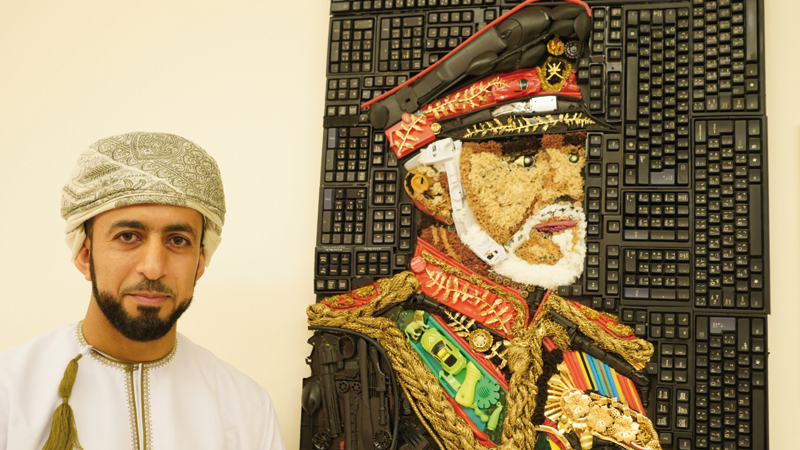


BY MARY OOMMEN -
While at first glance, the exhibits on display did not seem very different from the many portraits that we see of His Majesty Sultan Qaboos, a closer look revealed some amazingly creative and intricate work. Each of the 15 portraits were made using discarded material. This included everything from plastic shopping bags, old toys, fishing nets and unused wires to scraps of cloth and even discarded keyboards. The artists, who created these masterpieces had ingeniously recycled materials and literally turned trash into beautiful art.
The main concept behind the Eco-Art Plasbex exhibition organised by Arabian Art Academy was to send a strong message to people about the benefits of recycling and conservation, in line with His Majesty’s vision of preserving our environment. The rules for the Eco-Art Plasbex exhibitions weren’t too restrictive. The only requirement to participate in the exhibition was to ensure that the artwork was made almost completely from repurposed or recycled materials. Participants were given three weeks to submit their work.
The exhibition was inaugurated by Maryam Mohammed al Zadjali, Director, Omani Society for Fine Arts. She was part of a panel of esteemed judges who included Nezaar al Mushref, Abdullah Mohammed, Nuno Lobito and Giriraj Iyer.
One of the artists whose work immediately drew attention, and an award, was Sultan Hamed al Aamri. He used an interesting collection of broken plastic toys and unused computer keyboards to create an eye-catching portrait of His Majesty. Sharing why he chose to use toys, Al Aamri said, “we often do not realise the amount of plastic being used in the toys with which our children play. Plastic has been known to cause serious illnesses and is a health hazard. My use of toys is an attempt to convey the importance of keeping our children safe from the dangers of commonly used plastic toys, thus contributing in a small way towards making our world a safer place for our future generations.”
Another striking portrait was the one created by Martin Mbuta, who shared that he was deeply concerned when he found that Seeb beach, among others, was littered with nylon ropes, fishing nets and other types of plastic that was not only an eyesore but was also causing serious damage to the fragile ecosystem found off the shores of Oman. He discovered that “the fishing nets are too few for industrial recycling” and therefore end up being discarded on the beaches and in the sea.
He shared that his main objective to participate in the exhibition was to “encourage artists to think about what they can do to create greater awareness about environmental concerns. Through my artwork, I hope to inspire artists in Oman to think about repurposing waste through art, perhaps even move from the use of canvas to the use of fishing nets, as a medium, and in doing so support conservation.” Martin’s portrait was appreciated and awarded for the ingenious use plastic and fishing nets.
Like Mbuta, another artist who was awarded and recognised for his work was Ajayakumar Dayalan. He used an incredible 50,000 tiny bits of paper drawn from 200 Arabic magazines to create what he called ‘alphabet art’. The painstaking work took him almost 4 months to complete and so detailed was his art, which used just the right shades of paper, that it looked more like a painting than a collage. An accomplished artist, Ajayakumar has done similar portraits for King Abdallah of Saudi Arabia and has just completed one of Shaikh Mohammed bin Rashid al Maktoum of the United Arab Emirates.
Each of the works of art on display was an inspiration for visitors and presented the many possibilities available for converting the trash into reusable art. Prakash Puthur, for example, used plastic bottle caps, plastic shopping bags, coir, old buttons, copper wire and cardboard to make a stunning portrait of His Majesty.
Prakash said, “I consciously did not frame my art as I did not want to create boundaries. I wanted to convey that the possibilities of using trash for art are limitless.”
The disturbing environmental impact of the huge amounts of waste being generated today has spawned an active movement towards reusing, recycling and conservation in a big way, one which the Arabian Art Academy is championing in Oman.
Speaking on the occasion Maryam al Zadjali said, “…each and every participant created an impressive work of art by recycling trash. Art can be made from several things, the modern phenomenon of creating art from recycled material goes beyond painting walls. Hence, this creates a great opportunity for people who are seeking to present unusual works of art.”
Art has the power to influence people and spark interest and action. This is especially important for us in Oman where waste disposal is posing to be a challenge. Through initiatives like the Eco-Art Plasbex exhibition, participating artist and the Arabian Art Academy hopes to be able to contribute towards saving the planet, one piece of art at a time.
Oman Observer is now on the WhatsApp channel. Click here



